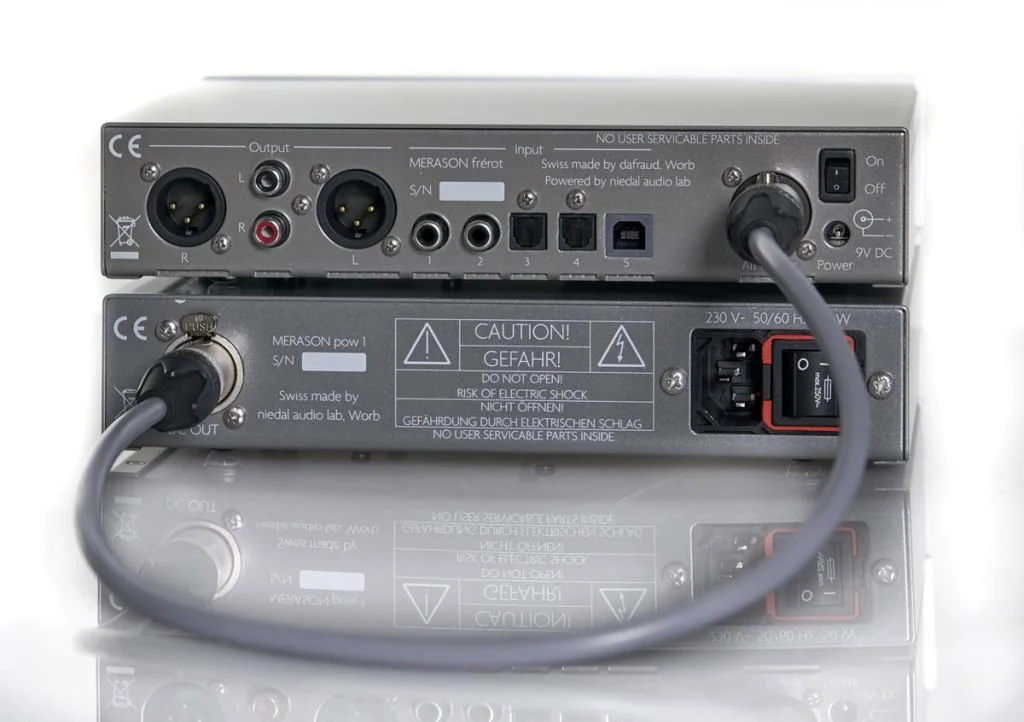MERASON FRÉROT DAC & POW1 - REVIEW
Color Me Stubborn
I have to admit to an enduring prejudice, having spent much of my career co–developing and promoting products that support the current common HRA or High Resolution Audio sample rates; 8 times 44,100 and 48,000. The former “44.1” is the Compact Disc sample rate, while 48k is the base digital video rate. That math comes out to 352.8 and 384kHz respectively. For music consumers, 4x 44.1 or 176.4kHz is a very high precision recording and playback format, and is easily downsampled without heroic mathematical efforts to 44.1k. When done carefully, 4x digital audio easily surpasses even the best analog in terms of measurable and, for me, subjective performance. Recent discoveries in DSP or Digital Signal Processing have even managed to capture the “magic” somehow embodied in analog tape, vacuum tubes and vinyl. Why, pray tell, am I telling you all this? Read on, gentle observer…
One of the many reasons why pro audio companies pushed the technical boundaries of sample rate, inching ever upward from that first 44,100 samples per second “Red Book” CD standard, was to increase the bandwidth or highest frequency that can be stored. Analog tape can encode quite high frequency, but it’s buried in steaming heaps of noise, so engineers wanted to do better. Starting with the initial “R–2R” or “multibit” digital–to–analog converter (DAC) designs, the process of transforming a stream of discrete numbers back into a continuous analog signal gradually improved to the point where now we have “delta–sigma” oversampling DAC chips with exceptionally good sounding (and measured) performance. All that blather leads me up to the actual topic at hand; Merason’s $1350 frérot + $950 pow1 USB DAC plus linear power supply. The frérot take a minimalist approach in keeping with the Merason motto of “Weniger ist mehr” or less is more. Rather than using a state–of–the–art, delta–sigma chip, the frérot leverages a now nineteen year old design.
Hick’s Law
Some DACs or Digital–to–Analog Converters allow you to dive deeply into their digital heart. The owner may decide to try different anti–image filter topologies‡ or to choose a solid or hollow state input stage. Choice is good…up to a point. Increased numbers of possibilities increases the amount of time it takes for someone to reach a decision. Welcome to Hick’s Law, where more options increase the time required to make a choice. With the Merason frérot, one need not worry. Its designer, Swiss engineer Daniel Frauchiger and founder of both Merason and OEM consultancy Niedal Audio Lab, believes that your ears, not specs, should be the final arbiter, and the old ways are best even when dealing with digital. His two piece, mid–priced frérot DAC plus pow1 external power supply are as free of clutter as they are of features. The frérot has two front panel LED indicators, one for power and another for input lock. The only other fascia property is a four–position rotary input selector. That’s it, Doctor Hicks. No information overload here.
Though the frérot can be powered from an included external 9v wall wart, for this review the much cleaner companion pow1 PSU was supplied. On the rear panel are balanced and unbalanced outputs, along with two AES-3 unbalanced digital inputs on RCA, two AES-3 optical ins on F05, and a single USB Type A socket for connection to a computer. For this review, I ignored the inferior, jitter–prone optical ins as well as the AES digital inputs, and focused solely on the frérot’s USB input.
Certain folks are driven as much by their eyes as they are by their other senses. I am not one of them. I’ll always appreciate an excellent example of industrial composition, but it’s the sound that really matters. Some companies also travel along a different path, a minimalist approach where many choices are made during the design process, presenting the consumer with fewer, more thought–through attributes and choices. Feature–wise, the frérot hews to a late ’90s view of digital, supporting 44.1k samples per second on up to 192k or 4 x 48kHz. En français, frérot means “kid brother,” and the frérot DAC shares an old skool converter with his big brother, the DAC1. Both products employ Burr–Brown’s 24 bit PCM1794A monolithic DAC chips, first released in the Digital Dark Ages circa 2003. Each chip is capable of stereo operation but is wired to provide a single channel for an extra 5 decibels of decreased noise floor.
Le Coeur de Mon Frérot
The Burr–Brown division of Texas Instruments (TI) refers to their 1794 as an “ultra high performance DAC,” with a top sampling rate of 192kHz. After much listening, Merason chose it for its sound quality. It is a “segmented DAC” design, whereby two sub–DACs are used, with each optimized for a different role. One DAC handles the MSBs or most significant bits, the loud stuff, while another handles the quiet LSBs or Least Significant Bits. The outputs of the two “segments” are then added together for the final signal. The 1794 implementation sits between delta–sigma and multibit, with a 6 bit delta–sigma segment for MSBs and an 18 bit, multibit approach for LSBs. The frérot presses a discreet Class A transimpedance amplifier into service to convert the DAC chip’s current output to a voltage with enough gain so your power amp is happy. Also serving the goal of better sound, all input signals are galvanically isolated to suppress noise, and the balanced outputs are realized electronically with, as distributor Mark Sossa wrote, “…four independent channels from the output of the two converter chips to the output of the frérot.”
In Use
Discussing tech is one thing, but what does the frérot plus pow1 actually sound like? After level matching my exaSound with the frérot, I started my explorations by enlisting Malay jazz keyboard prodigy Joey Alexander. After digging into his wonderful (as my child would say, “Literally!”) 2020 release Warna to get my bearings, I moved ahead to this year’s Origin [both Qobuz 96k]. The first thing that struck me was the differences between the two recordings. The older recording exhibited a compressed soundstage, with the piano snuggled up in front of the drums. Origin had a more believable, more defined, ambient soundstage with a more contemporary sonic signature. The frérot nicely delineated those differences, while presenting a relaxed, well balanced sound in keeping with Alexander’s evolving composition and band leadership.
What I first thought was loss of top-end extension and air turned out to be something far more subtle and interesting; texture and the “space around the notes.” Many folks hold the opinion that “digital” has a harsh and unpleasant sound quality relative to “analog.” Comparing the Merason with my $3k exaSound, which is based on ESS Technology’s Sabre delta–sigma DAC chip, clearly illustrates the differences. On Tank and the Bangas’ 2022 R&B album Red Balloon [Qobuz 44.1], vocals on the track “Stolen Fruit” have a modern scratchiness, what sounds to me like Pro Tools’ misshapen fingerprint. The Merason polishes off the raspiness without removing detail. At the same time, it spackles over some of that space in between the notes. In comparison, the exaSound retains the unpleasant texture but communicates more of the emptiness between each aural event. Two contrasting approaches to rendering the same data, subjectively quite similar to a smoother DSD version when compared to a sharper PCM version of the same song.
One band I revisit a few times a year is Dire Straits. The newly released compilation, Money For Nothing [Qobuz 192k], affords a fresh view into the brilliance of both band and Bob Ludwig’s mastering. The acerbic tongue in cheek title song, not to mention its pioneering Minecraft–style music video, is a perpetual delight. During this listen, I was focused on Mr. Stingy’s vocals when I noticed the cowbell that shows up near the end…more cowbell! Seriously, perceived transient response, guitar bite and vocal fry, are telegraphed from the frérot with a more velvety touch that my converters with delta–sigma hearts.
There were two other aspects that I sought for a better understanding of Daniel Frauchiger’s view of sound quality; air and ambience. I think of air as the very top of our perception, those very high frequencies and yes, ultrasonics, through which I am informed of distances, room boundaries and a certain hint of reality. A 176.4kHz sample rate will encode half that frequency, or 88.2kHz, which captures ultrasonics nicely without undo temporal distortion. Listening to 176.4kHz HRA recordings from engineers Morten Lindberg (2L) and Dr. Keith Johnson (Reference Recordings), I found the frérot to not be the champ at conveying airiness, but it does paint a finely textured picture nonetheless. By the way, at the other end, the frérot holds its own in the bottom octave.
Conclusions
Despite my misgivings about outdated tech, there were no instances where I felt the frérot + pow1 was left wanting. The design path that was taken results in a refreshingly straightforward solution for digital audio playback. The combination of very reasonable price and high performance should be embraced by the vast majority of audiophiles, who cannot afford to trade in their car to fund a DAC purchase. Plus, it’s the opposite of a typical budget priced DAC, where so many features are packed in by the marketing department that it purposefully boggles the mind of inexperienced buyers. The frérot + pow1 deliver that essential and elusive audio quality; verisimilitude. Pair it with other better quality components, and you have the makings of a very high performance and potentially modestly priced two channel system. Personally, I can attest to the match with a more forward speaker to provide some balance and restraint. In my case, it was the set of Starke Sound IC-H1 Elite bookshelfs I had in–house during this review, but could have just have easily been a pair of Joseph Audio or Von Schweikert speakers, examples with aggressive “detail.” As a self confessed effete digital audio snob, I was pleasantly surprised by the easy going presentation, welcome simplicity and outstanding value of Merason’s frérot and matching pow1.
Additional Gear:
Source — Amarra Luxe
Amplification — Parasound JC 5
Conversion — exaSound e22 Mk. II
Cabling — ANTICABLES Level 3.1 speaker, Soundstring GEN II Beta 2-22S XLR, VUE Cables Digital VU-3 USB
US importer:
Merason Frérot $1350
Merason pow1 $950
Mark Sossa, Well Pleased AV
https://wellpleasedav.com/






